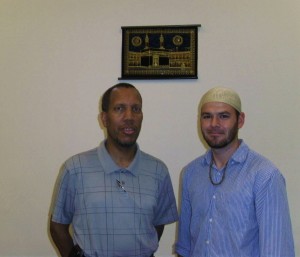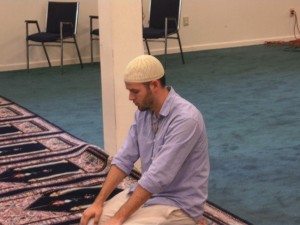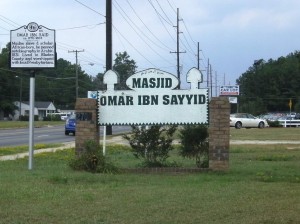On the surface, I stick out at Masjid (mosque) Omar Ibn Sayyid like a snowflake on coal in the predominately African-American congregation, but that’s where the differences end.
A man, whose name unfortunately escapes me now, walked up to me at the end of jum’ah (Friday prayers) with a warm smile, took my hand in both of his and said, “Welcome back home, Brother Andrew.”
He’s only seen me once before, but welcomed me “home.” I’m also “Brother Andrew.” I’ve heard that filial title before, and it never gets old.
My congregational home this month is Masjid Omar Ibn Sayyid in Fayetteville, North Carolina. I attend jum’ah there every Friday around 1:15 in the afternoon to connect with the Muslim community and meet up with my Islamic Mentor, Mr. Adam Beyah.

Mr. Beyah is a local accountant, former imam at Masjid Omar Ibn Sayyid, and an active member of the inter-faith movement in the Fayetteville area. Mash’Allah, I got lucky!
The local masjid is the Muslim community’s social and spiritual heartbeat. Let’s take a look at how an average visit to a masjid might go:
First, we enter the building. This month, you may be greeted with “Ramadan mubarak” or in English, “Blessed Ramadan.” On most occasions, it might be “Assalamu alaikum” or “Peace be upon you.” To reply, we say “Wa alaikum assalam,” or “And peace be upon you.”
Next, we take off our shoes and place them in a cubbie area. As with most Eastern traditions and cultures, shoes and feet are considered unclean. Never point your feet at anyone or have shoes around the Qur’an or other important items.
Then we made wudu, a ritual wash usually in a communal bath area separated by men and women. Here, we wash the hands, forearms, face (mouth, nostrils, ears, hair), and feet. We are now ritually clean to enter the prayer area.
Once you enter the prayer area, men sit in the front and women in the back. The rational for this arrangement is that, during prostrations, the men will not have the temptation to look up at the women’s backsides. As my World Religion teacher (a woman) once pointed out however, “Women like to look too,” but I digress. Muslims enter the masjid in modest dress.
When entering the prayer area, make your sunnah prayer, which is equal to the fajr morning prayer, and then sit on the floor. Next, the imam gives a talk on various Islamic subjects for about an hour or more called a khutbah, this is immediately followed by the communal prayer similar to the first one in which the males up front and the females behind line up toe-to-toe and shoulder-to-shoulder and perform the salaat as one. It is with this action that the Muslim community moves as one, spiritual organism. You have not experienced Islam until you are part of this movement.
That is the core of the masjid visit.
Here at the masjid, Muslims connect with one another and support not only fellow Muslims, but the surrounding area. In fact, Masjid Omar Ibn Sayyid partners every year during Ramadan in a food give-away with the local food bank, totalling in thousands of dollars in free meals for the needy. Mentor Beyah also broached my idea for a food drive, calling on all members of the masjid to pull from their own resources and give additional food to the community. Inshallah, this will come to pass and echo as part of their outreach program down the road.
And it gets more awesome.
This local masjid is named after Omar Ibn Sayyid, a man sold into slavery from Africa who became Muslim teacher, scholar, and author of the only autobiography written in a native language (Arabic) by a slave in the U.S. He is noted as one of the most educated practicing Muslims slaves in the nation and is credited with penning much of the Qur’an from memory and writing an Arabic translation of the Bible, now on display at Davidson College Library.
Sadly, few people in the community outside of Islamic and African-American studies know much about Omar’s life. My Mentor, Mr. Beyah expressed the importance of understanding our history in an article written in the Fayetteville Observer:
“When talking about history, all segments of history should be taught,” said Adam Beyah, a former imam of Masjid Omar Ibn Sayyid. “I take the position the more we can learn about ourselves, the more we can learn to be contributors of society. Somebody has to tell our story.”
An official state road marker which bears Omar’s name also stands outside the masjid.
For more info on this extraodinary man, see the full story in the Fayetteville Observer.
So this is my home for the month, and therefore, my own adopted legacy. I had no idea about the history, significance, or even the presence of the Muslim community here, and honestly, I’m a little embarrassed by that fact.
But here I am…

…And here we are.
There are a few events going on this month at my masjid that, inshallah, I will take part in. Included are an iftar dinner (the meal after one breaks the fast) and the food initiatives. I invite you to visit a masjid in your community and connect with your Muslim neighbors. You might stand out at first, but if you relax and let the melody of the adhan (call to prayer in Arabic), congregational reverence, and friendly faces caress your anxiety, you may just find a few new brothers and sisters you never knew you had.
Oh and by the way, Muhammad Ali also visited my masjid back in the day. Yeah, the boxer.


